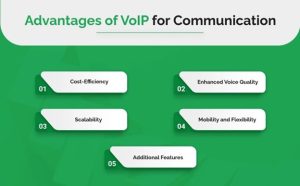
Crystal Clear Conversations: The Wonders of VoIP for Seamless Communication
Table of Contents
Currently, VoIP phone systems are used by about 31 percent of businesses globally.
The world has undergone globalization, where communication and collaboration have become essential. In this case, we cannot stress enough on the importance of clear and uninterrupted conversations. However, where can we find a reliable means for crystal clear communication?
The simple answer is Voice over Internet Protocol (VoIP).
Yes, you read that right, we can embrace the power of VoIP to enhance our communication in today’s world. So, in this blog, we will discuss the winders of VoIP for seamless communication and how it enables crystal-clear communication. Let’s start by understanding VoIP.
What is VoIP?

Voice over Internet Protocol, or simply VoIP, is a cloud telephony system that enables communication like voice calls, video calls, and message services via the Internet. VoIP is a disruptive telecommunication advancement that has changed the way we communicate for the better.
Voice over IP eliminates the hassles of setting up telephone lines and creating communication infrastructure. In short, VoIP calls and messages can be made and received using only a device and an internet connection.
When we think about communication via the internet, Voice over IP appears to be a sophisticated form of communication. However, trust us when we say it has an effortless way of operating.
First, the VoIP system uses “analog-to-digital conversion,” where the analog data from the sender is transmitted into digital data.
After the successful transmission, the data is further transmitted into smaller packets called “VoIP Packets” before being sent over the internet. After the transfer, the digital data is converted back into analog data, which the receiver can use. This process happens simultaneously, and the communication process is rapid.
Advantages of VoIP for Communication

- Cost-Efficiency
Are you in need of a way to save money and resources in your business? Then VoIP communication is the thing for you. The first benefit is it eliminates the cost of setting up communication infrastructure, telephone wiring, and various lines. Costs that come with traditional phone lines.
But wait! There’s more! It also helps reduce costs on international calls. You read that right: no additional charges. Thus saving you money on long distances and international calls.
- Enhanced Voice Quality
Given your stable internet connection, VoIP offers one of the best voice-quality calls. Moreover, VoIP has a decreased risk of failure in telephone lines, communication infrastructure, and hardware equipment, which can result in better voice quality. The enhanced voice quality makes VoIP an ideal choice for personal and professional use.
- Scalability
Next on the list, scalability is one of the prominent advantages of VoIP. VoIP is a highly scalable communication channel. This means you can increase or decrease the number of phone lines and users as needed.
So, if your business grows, you can open a new branch without issues. Similarly, if your business is not doing so well lately, you can seamlessly downsize your business.
- Mobility and Flexibility
Unlike traditional phone systems, VoIP does not require a physical location. The service allows users to make and receive calls from anywhere they have an internet connection. As a result, it is ideal for remote work, telecommuting, and businesses with mobile employees. The availability of softphones and mobile apps further enhances the mobility of VoIP.
- Additional Features
Last but not least, VoIP comes with several features that enhance the communication process. For example, it offers features like video conferencing, voicemail, Interactive Voice Response (IVR), call monitoring, immediate call forwarding, and many more.
Implementation of VoIP
Implementation of VoIP needs careful planning and effective execution. A small mistake can lead to the failure of successful implementation and operation of VoIP. So, let’s discuss how to implement VoIP easily and efficiently.
- Setting up a VoIP System
The first step of implementing a VoIP system is to set up the system, which can be started by configuring your current network. Assess if your internet connection can handle the Voice over IP call volumes. Consider upgrading your internet if required and implement Quality of Service (QoS) to facilitate VoIP calls.
After that, choose the best VoIP protocol, like SIP (Session Initiation Protocol), which is compatible with your system. Next, choose either softphones or physical phones as per your business requirements. Once you decide on the phone type, it is time to select PBX (Private Branch Exchange), which is very important for using various VoIP features like call routing.
If needed, configure your existing phone numbers and port them to the VoIP system. Finally, ensure that your VoIP system is protected from threats by implementing security protocols such as encryption and firewalls.
- Hardware and Software Requirements
The next step is acquiring the hardware and software requirements. Start this process by setting up the goals and objectives for your VoIP system and provider.
After that, ensure your phones are compatible with VoIP (only if you use physical phones instead of softphones). Likewise, you’ll need appropriate PBX hardware and software if your company uses an on-premises PBX.
VoIP gateways or adapters are needed to connect VoIP calls to conventional telephone lines, so ensure to acquire them. Finally, having a router and switch of high quality will help ensure a smooth VoIP call flow.
- VoIP Service Providers
The final step for implementing a VoIP system concerns VoIP service providers. Start this step by choosing the best VoIP software available for you. Consider factors like price, features, compatibility, customer reviews, scalability, and compatibility before investing in a provider.
Register and sign in with your chosen VoIP provider. The process usually involves creating an account and selecting the features you’d like to use. Your VoIP phone or softphone must be configured according to the instructions provided by the provider.
Next, run various tests to ensure that your VoIP system is working as intended, and also offer employee training for the best use of your VoIP. Finally, conduct continuous monitoring for seamless operation.
Ensuring Crystal-clear Clear Conversations
- Quality of Service (QoS)
First and foremost, implement Quality of Service (QoS) to prioritize VoIP calls over the transmission of other data, which ensures that the calls do not have jitter and latency. Moreover, you can continuously monitor your network’s traffic to identify and resolve any congestion or bottlenecks affecting call quality.
- Bandwidth Requirements
Determine the number of simultaneous calls you will have and how much bandwidth each call will require. Check your internet connection’s capability to handle the call load. You should keep an eye on both upstream and downstream bandwidths. However, upstream bandwidth is more critical when considering VoIP because it determines how well you can transmit voice data.
Choosing the right audio codec can also affect bandwidth requirements. While some codecs consume more bandwidth but provide better audio quality, others consume less bandwidth, which may deteriorate the quality.
- Common Issues and Troubleshooting
Finally, there are some common issues that might arise while using the VoIP phone system. However, you dont have to worry about such issues as we have brought some effective troubleshooting tips for these common problems.
For instance, some common issues might be call jitter, packet loss, codec mismatch, latency, sound echo, firewall, and IDS issues. These issues can be easily addressed by using a good internet connection from a reliable provider, using the QoS option on the internet, using a noise cancellation device, proper firewall configuration, and network address translation (NAT).
Finally, updating the software application and maintaining the hardware equipment are always recommended to avoid unforeseen problems.
Use Cases and Industries Benefiting from VoIP
- Business Communication
VoIP has become one of the most reliable communication channels for business communication. Employees, teams, and departments can communicate, collaborate, and connect from anywhere in the world. Furthermore, various features like conference video calls, voice mails, call forwarding, and routing have made business communication more efficient.
But wait, there is more! Businesses can use VoIP to interact with customers, clients, suppliers, and others.
- Remote Work and Collaboration
Remote work has become a trend, and its integration has increased rapidly. For example, Forbes estimates that 32.6 million Americans will work remotely by 2025, which is about 22% of the total American workforce.
VoIP is one of the top tools for remote work and collaboration. It is one of the reasons why people can work from far corners and stay connected to their offices and coworkers. All it takes is a simple device and an internet connection. But that’s not all, you can also collaborate on projects, participate in meetings, and attend virtual conferences.
The best part about VoIP is how well it integrates with other collaboration tools like screen sharing, video conferencing, and instant messaging. Connecting with your team has never been easier.
- Customer Support and Service Centers
VoIP is heavily used in customer support and service centers. Businesses can give their customers a cheap or free way to communicate with toll-free numbers. On top of that, organizations can use it to serve international customers.
Lastly, there’s another advantage businesses get by using VoIP: they have access to so many tools and features that they can then use to offer the best service. For example, they can use VoIP to send customer calls where they need to go, which reduces wait time and makes customers more satisfied.
- Healthcare and Telemedicine
Telemedicine is an emerging practice where patients can get medical assistance, suggestions, and services virtually. This type of service comes in handy when patients are far from a medical facility and going there isn’t really feasible.
Healthcare providers can use VoIP for two things: to remind patients about appointments and follow-ups and to provide patient support, all while improving a patient’s overall health.
- Education
The virtual classroom is becoming more popular among educational institutions. Teachers use technology like this for online lectures, interacting with students, and sharing resources remotely. As early as 2000, the trend of online classes has increased drastically.
Based on a report published by Delvinpecks, an estimated 70% of students prefer online classes to traditional classes.
Security Considerations in VoIP

- VoIP Security Threats
- Eavesdropping: Eavesdropping is a common security threat in VoIP, where attackers and hackers get access and listen to the conversation without consent.
- Phishing: Phishing involves attackers sending fraudulent phone calls to trick users into divulging personal or financial information.
- Spoofing: Spoofing refers to presenting malicious callers as legitimate ones, which can cause fraud or identity theft.
- Denial of service (DoS): In DoS, attackers overflow data and information in the VoIP system, which causes various issues like degradation in call quality, latency, or downtime.
- Call Interception: Lastly, there are also the risks of call interception. Call interception occurs when an unauthorized party can intercept a call in progress and manipulate the content, posing a security and privacy threat.
2. Measures to Protect VoIP Systems
- Implement Firewalls and Intrusion Detection Software (IDS): Use firewalls and intrusion detection software to add an additional layer of protection to your VoIP and get an alert if your system is under attack. This can help you prevent most issues and take necessary action when needed.
- Use Encryption: Encryption is one of the most effective ways to avoid security issues. Consider using powerful encryption like end-to-end encryption. Moreover, you can use protocols like SRTP (Secure Real-Time Transport Protocol) to prevent common security issues.
- Regular Updates: Software updates come with various security and bug patches. Moreover, these updates usually include changes for addressing software vulnerabilities. Hence, update your software as soon and as frequently as possible.
- Manage Access Control: Set up VoIP so only authorized users and devices can access VoIP systems. Use strong passwords, two-factor authentication, and secure provisioning methods.
- Training and Education: Lastly, educate and train users, employees, and administrators on VoIP security best practices, such as recognizing security threats, how to report the threats, and how to handle different situations.
Future Trends in VoIP

Voice over IP has evolved a lot, addressing the modern communication need. While we have already witnessed many changes, we can anticipate more changes. So, here are some potential future trends in VoIP.
- VoIP and 5G
5G is the most advanced mobile network known for its high bandwidth and speed that enable ultra-high-definition video and data volumes. The 5G can be integrated into VoIP, significantly improving connectivity.
Integrating VoIP and 5G, mobile VoIP applications will benefit from faster and more reliable connections, even in remote areas. With 5G networks, there is less latency, which is crucial for real-time communication. It will result in even better voice and video quality for VoIP calls.
The improved speed in connectivity might increase VoIP use across various businesses and markets.
????You might also be interested in 5G For Laptops – Is 5G For Your Laptop?
- Integration with Artificial Intelligence (AI)
People want convenience in every aspect of their lives, and communication is no exception. Although convenience in communication can be tricky, Artificial Intelligence (AI) has brought the right tools and features to enhance communication.
First, AI has introduced virtual assistants that can initiate calls, send messages, and access VoIP features through voice commands, enhancing user experiences. For example, AI-powered virtual assistants like Google Assistant, Siri, and Alexa have become prominent in improving user experience. We might see more of these innovations very soon.
It only gets better from here. Artificial intelligence will soon help reduce background noise, enhance voice clarity, and improve network performance to improve call quality. Finally, artificial intelligence-powered chatbots might be ideal tools for handling routine inquiries and referring callers to human agents when necessary for customer support.
- Sustainability and VoIP
Last but not least, VoIP will play a huge role in sustainability. VoIP uses very little energy for operation compared to traditional phone systems, as there is no need to power telephone lines and communication infrastructure. As a result, using VoIP can help save precious energy.
Likewise, using cloud-based VoIP systems will reduce the need for on-site hardware and the energy consumption associated with data centers, contributing to sustainability. As remote work becomes more prevalent, VoIP will likely contribute to overall sustainability efforts as it reduces the need for physical office space and commuting for employees and other resource-saving.
Finally, various VoIP features like video conferencing, voice mail, and team collaboration tools can be used for replicating office spaces, saving many resources and reducing the carbon footprint.
Also Read: Intel’s 14th Gen Processors Leak Out Thanks To MSI
Conclusion
Summing up, VoIP is a must-have tool for businesses and individuals if they want to have a reliable means of communication for crystal-clear conversations. Although using VoIP has several advantages, implementing it can be slightly sophisticated. So, you can follow the steps and process mentioned above to effectively and successfully integrate Voice over IP in your communication.
The use of VoIP has been expanding across the various businesses and industries. So, it is a perfect time to shift towards this communication marvel. Finally, remember to consider the various security considerations and future trends in VoIP for the best use.

